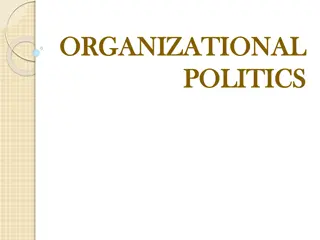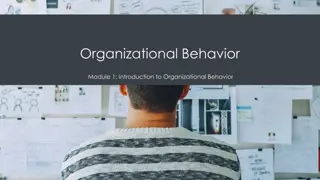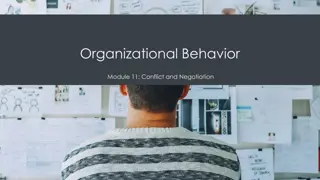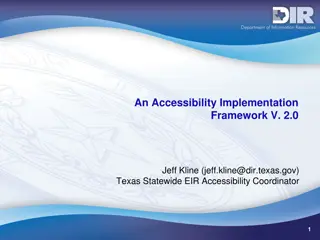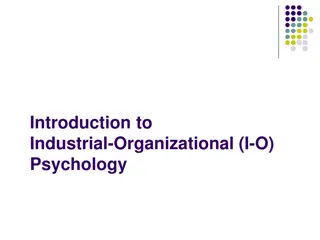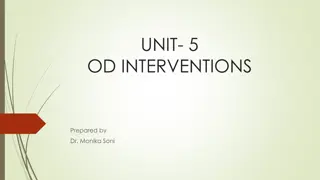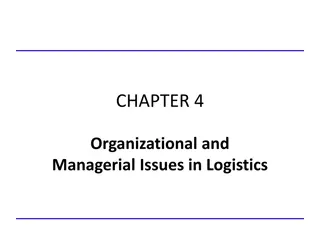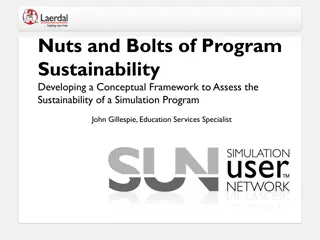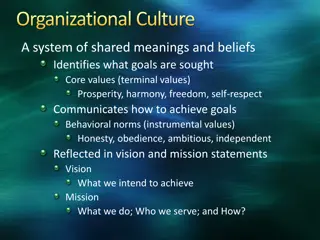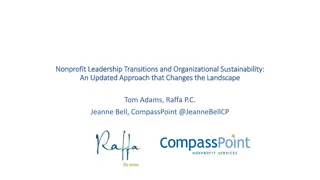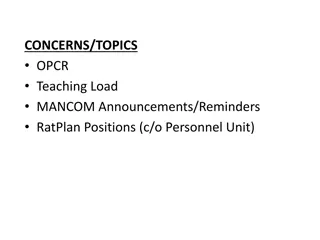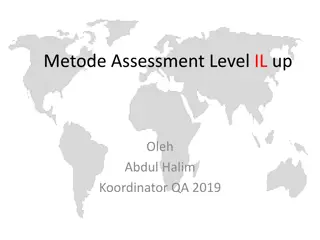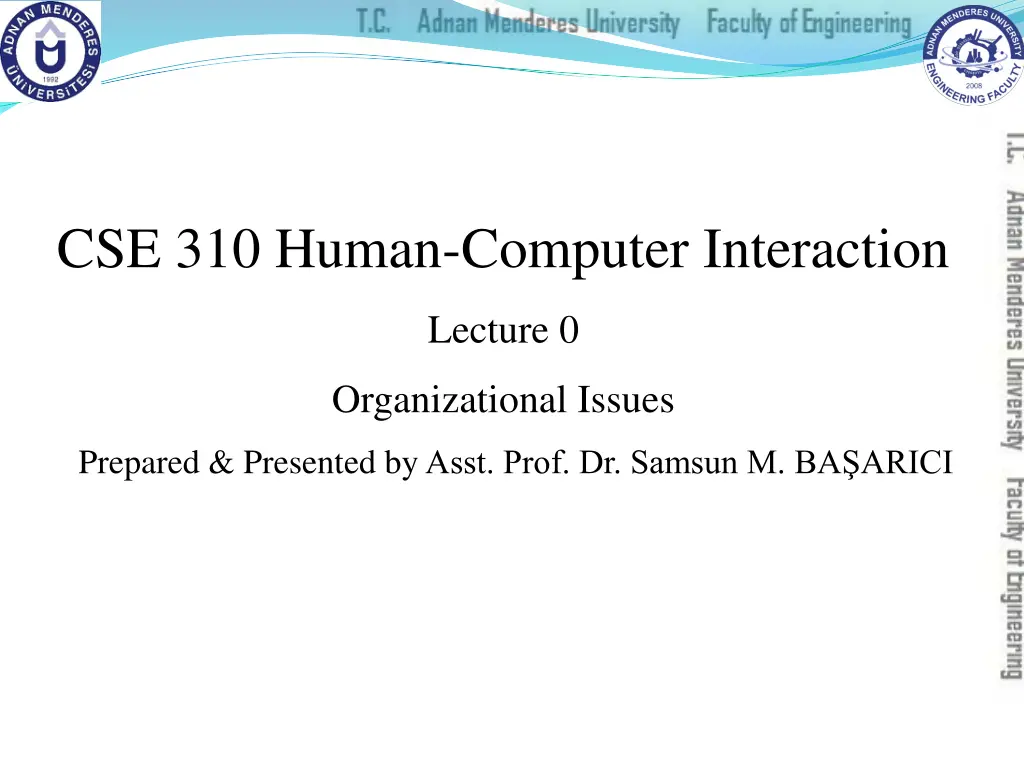
Understanding Human-Computer Interaction: Course Overview and Objectives
This course provides an introduction to human-computer interaction, focusing on understanding the basic principles of interaction, cognitive abilities of humans, designing efficient interfaces, and analyzing existing models. Students will learn to create interfaces that enhance user experience and address socio-organizational and cultural aspects of interaction. Taught by Asst. Prof. Dr. Samsun M. Ba.ar.c., the course aims to equip students with the knowledge and skills necessary for effective human-computer interaction.
Download Presentation

Please find below an Image/Link to download the presentation.
The content on the website is provided AS IS for your information and personal use only. It may not be sold, licensed, or shared on other websites without obtaining consent from the author. If you encounter any issues during the download, it is possible that the publisher has removed the file from their server.
You are allowed to download the files provided on this website for personal or commercial use, subject to the condition that they are used lawfully. All files are the property of their respective owners.
The content on the website is provided AS IS for your information and personal use only. It may not be sold, licensed, or shared on other websites without obtaining consent from the author.
E N D
Presentation Transcript
CSE 310 Human-Computer Interaction Lecture 0 Organizational Issues Prepared & Presented byAsst. Prof. Dr. Samsun M. BA ARICI
About this Course Course Code Course Hour/Week Course Title Semester ADU Credit ECTS Theory 3 Practice 0 Introduction to Computer Applications CSE 310 Spring 3 6 Course Type 1. Compulsory Courses 1.1. Programme Compulsory Courses X 1.2. University Compulsory Courses (UFND) 1.3. Y K (Higher Education Council) Compulsory Courses 2. Elective Courses 2.1. Program Elective Courses 2.2. University Elective Courses 3. Prerequisites Courses 3.1. Compulsory Prerequisites Courses 3.2. Elective Prerequisites Courses Organizational Issues 2
About this Course (Cont.) Language of Instruction English Associate Degree (Short Cycle) Undergraduate (First Cycle) Graduate (Second Cycle) Doctoral Course (Third Cycle) Level of Course Special Pre-Conditions of the Course (compulsory) None Special Pre-Conditions of the Course (recommended) Mail: sbasarici@adu.edu.tr Web: http://akademik.adu.edu.tr/fakulte/muhendislik /personel/sbasarici/anasayfa Course Instructor(s) Dr. Samsun M. Ba ar c Organizational Issues 3
Main Objective(s) of this Course In this course it is intended to understand the basic principles of interaction and construct efficient interfaces intended for the cognitive abilities of human. Students participating this course will learn the cognitive facilities of human and how to use these abilities for a better interaction with the computer. human computer effective and Organizational Issues 4
Learning Outcomes of this Course Upon successful completion of this course, students will Be able to define the basic concepts of human computer interaction Understand the cognitive abilities of human. Understand the technical capabilities of the computer and the interaction methods. Construct the concepts for a better interaction using the terms mentioned above. Create interfaces Analyze the existing models and methods Organizational Issues 5
Course Content Basic concepts of human computer interaction Cognitive abilities of human Characteristics of a computer and how to answer the rich cognitive channels of human with these characteristics; Designing an effective interaction Critical approach to existing models and theories Socio-organizational and cultural issues and aspects Organizational Issues 6
Resources Alan Dix, Janet Finlay, Gregory D. Abowd, Russell Beale, Human-Computer Edition , Prentice Hall, 2004, ISBN: 0-13-046109-1 Interaction, 3rd Required Course Material (s) /Reading(s)/Text Book (s) Lecture Notes Dov Te eni, Computer Organizational Information Systems , Wiley & Sons, 2006, ISBN: 978-0471677659 Jane Interaction: Carey, Phing Developing Zhang, Human Effective Douglas Whitman, Cognition, 1st Ed. ; Wiley & Sons, 2010, ISBN: 978-0471715665 Recommended Course Material (s)/Reading(s)/Other Margaret International Student Version, 7th Ed. , Wiley & Sons, ISBN: 978-0470409473 W. Matlin, Cognitive Psychology, Organizational Issues Othersourceswill be announced 7
Course Schedule (Weekly) Methodology and Implementation (theory, practice, assignment etc) Week Topics Preliminary Preparation Foundations interaction; Human and its cognitive characteristics Human and its cognitive characteristics (cont.); Characteristics of computers and interaction Characteristics of computers and interaction (cont.); Paradigms Interaction design basics of human computer Theory 1 Theory 2 Theory 3 Theory 4 Human computer interaction in software process Theory 5 Implementation support and evaluation techniques Theory 6 Universal design Theory 7 Organizational Issues 8
Course Schedule (Weekly) (Cont.) Methodology and Implementation (theory, practice, assignment etc) Preliminary Preparation Week Topics MIDTERM EXAM WEEK 8 MIDTERM EXAM WEEK 9 User support Theory 10 Cognitive models Theory 11 Socio-organizational issues and requirements Theory 12 Communication and collaboration models Theory 13 Task analysis; Dialog notations and design General Repetition Theory 14 Theory 15 FINAL EXAM 16 Organizational Issues 9
Assessment SemesterActivities/ Studies NUMBER WEIGHT in % Mid- Term Attendance Quiz Assignment (s) Project Laboratory Field Studies (Technical Visits) Presentation/ Seminar 1 - - 40 - - - - - - - - - - - - Practice (Laboratory, Virtual Court, Studio Studies etc.) - - Other (Placement/Internship etc.) - - TOTAL 40 Contribution of Semester Activities/Studies to the Final Grade 40 Contribution of Final Examination/Final Project/ Dissertation to the Final Grade 1 60 TOTAL 100 Organizational Issues 10
Assessment (Cont.) Final Grades will be determined according to the Adnan Menderes University Associate Degree, Bachelor Degree and Graduate Degree Education and Examination Regulation Organizational Issues 11
Responsibilities of the Students Obtaining the text book(s) Coming to the course with a good preparation Completing the exercises with individual efforts unless told otherwise Following the rules set by the responsibles for the course and the implementation/lab. studies HONESTY !!! Organizational Issues 12
Plagiarism Plagiarism will not be tolerated Projects without references: a penalty of 20% Submitting your own work that has been earlier submitted to satisfy the requirements of another course is (self)-plagiarism (also called double dipping) Copying a journal article or a section of a book or code from an article or book and submitting it as your own is plagiarism Organizational Issues 13
Plagiarism (Cont.) Using significant ideas from someone else, but putting them in to your own words and not acknowledging the source of the ideas is plagiarism Copying an essay, code, work etc. from another student and submitting it as your own is plagiarism And PLAGIARISM is THEFT So don t steal (Nobody likes thieves) Organizational Issues 14



